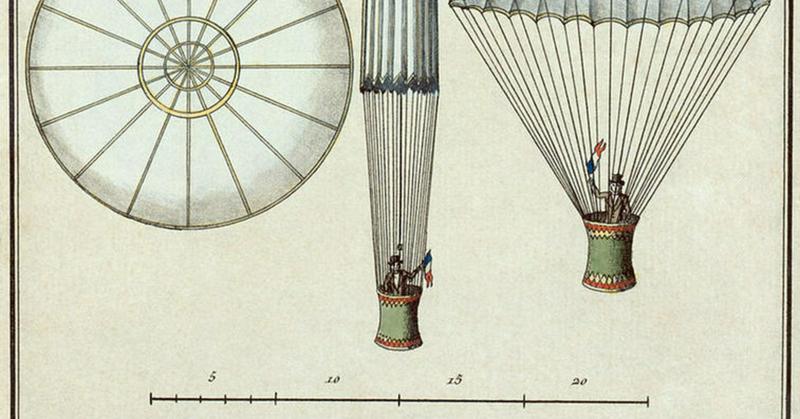1797: First Ever Parachute Jump Is Made Over Paris
By | April 9, 2021

Parachuting is one of the most exhilarating experiences in life, according to the hundreds of thousands of people who decide to take the plunge each year. While over three million jumps from airplanes occur every year in the United States alone, parachuting as a practice began long before the invention of flight. In fact, the first parachute jump took place in 1797, a good 106 years before the Wright Brothers ever got their craft off the ground.
The Flying Frenchman
That was the year André-Jacques Garnerin, French physicist, veteran of war, and balloonist extraordinaire, took his miraculous first jump. Born on January 31, 1769, Garnerin grew up in beautiful Paris and soon fell in love with both ballooning and revolting. During the French Revolution, he was a proponent of using massive air balloons (the only real way of flying at the time) for war purposes, but he was captured and spent three years as a prisoner of war in present-day Hungary. While wasting away in miserable conditions, Garnerin often imagined escaping his torment by jumping off the tall prison walls to freedom.
Luckily, Garnerin was released before he resorted to leaping and went on to study ballooning further with fellow famed French scientist Jacques Alexandre César Charles, who had mastered the art of ballooning, being one of the first to successfully get off the ground after studying the effectiveness of hydrogen as a propellant. Throughout the 1780s, Charles showed off his invention of what we would now call a hot air balloon to hundreds of thousands of awed spectators, including one of America's own Founding Fathers, Benjamin Franklin.

The First Parachute Jump
While Charles was enamored with what went up, Garnerin was more focused on what came down, devising a creative—albeit highly dangerous—method of jumping from the balloon while it was more than 3,000 feet above ground. Essentially, he used a giant balloon to lift the umbrella-shaped parachute, which was tied closed, thousands of feet in the air before opening the seven-meter nylon chute and cutting its ties to the balloon. Any tiny error or injury to the parachute would have resulted in catastrophe, and Garnerin made more than a tiny error during his first jump on October 22, 1797, when he failed to account for the power of the air pressure and wind at that altitude. He later realized that maybe a small air vent would be useful for controlling the giant contraption.
The basket waved back and forth with violent force, and the young Frenchman held on for dear life as it slowly made its way downward, swinging like a pendulum all the while. The landing was not kind, but happily, the first parachutist was not seriously hurt when he finally landed over a mile from where he cut the line to the balloon. Over the next couple of years, he tinkered and enacted flight after flight until he proved to his critics and fans alike that he could indeed control his descent.
His next step was to take a partner, specifically his wife, Jeanne, but the French government frowned on the idea of a woman partaking in his ventures, citing concerns ranging from fertility to indecency. Eventually, they all came to the understanding that as long as the woman on board knew the risks involved, she was allowed to make her own decisions. Post-Revolution France was a free country, after all. A few years later, Garnerin was finally allowed to take Jeanne along with him on October 12, 1799, when they jumped together from another 3,000 feet above ground. They landed with ease, finally proving once and for all the worthiness and surprising safety of his experiment.

Parachuting Today
Parachuting mostly existed as a thrilling pastime until it found a military purpose in World War I, as its inventor had always intended. It was mostly used as a method of escape from the observation balloons that frequently met their demise as long-ranged weapons became more reliable. By World War II, the advent of paratroopers changed the face of war, and more than 13,000 Americans and 1,000 more British soldiers landed on the beaches of Normandy Bay in the wee hours of June 6, 1944, A.K.A. D-Day. Armies across the world still use paratroopers because of the ease and reliability of the modern-day parachute and quiet, covert method of infiltration the tactic allows.

